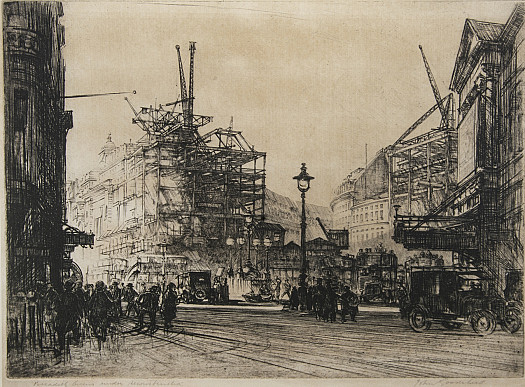John Charles Goodchild (1898-1980)
Born and partly educated in London, John Goodchild achieved great success in Australia as an artist and teacher. He remains best known as a painter, printmaker, illustrator and poster designer of landscape subjects.
John Goodchild was born in Southwark, London, on 30 March 1898, the fourth of nine children of the journeyman lead-glazier, John Goodchild, and his wife, Jessie (née White). He was educated at the Strand School, based at King’s College, as the result of a scholarship. In 1913, he and his family emigrated to Australia, and settled in Adelaide, South Australia. During his teens, he worked at several jobs, including one in a bakery and another as a sign writer.
In 1917, Goodchild joined the Australian Imperial Force.
He served in the First World War as a stretcher bearer with the 9th Field Ambulance on the Western Front, and made also medical drawings. In the following year, while recuperating in a hospital near Le Havre, he contributed drawings to the Australian Army newspaper, The Digger. At the end of the war, he received a commission from Australia House to draw war cemeteries in France for the publication, Where the Australians Rest (1920).
Following his return to Adelaide, Goodchild studied at the South Australian School of Arts and Crafts, and produced Adelaide in Pen and Ink Drawings (1920). In about 1921, he spent some in London, taking classes at the Central School of Arts and Crafts. Back in Adelaide, he earned a living as a commercial artist and also a teacher of etching at the South Australian School. He held a solo show of etchings in Adelaide in 1923, and also exhibited in Sydney as a member of the Australian Painter-Etchers (and Graphic Art) Society, of which he became Vice-President.
Soon after Goodchild married Doreen Rowley in Adelaide in 1926, he and his wife went to London, so that they could both study at the Central School, he focussing on engraving and lithography and she on clay-modelling. During their years in Europe, they visited Italy (and John produced etchings of Florence and Venice). In 1929, they settled in Adelaide, and established a studio there. He began to exhibit watercolours at the South Australian Society of Arts, which received its royal warrant in 1935, two years before he was appointed its President. He designed furniture, panels in bas-relief, the lamps and pylons for Adelaide City Bridge, which opened in 1931. From 1935, he collaborated with F Milward Grey on a series of posters for the South Australian Tourist Bureau.
Goodchild was a member of the boards of the Public Library (1938-53, 1960-69) and the Museum and Art Gallery (from 1940 National Gallery of South Australia), and Principal of the School of Arts and Crafts (1941-45).
In March 1945, Goodchild became an official war artist for the Australian War Memorial, Canberra, and was attached to the Royal Australian Air Force. In this position, he produced several dramatic watercolours. On 2 September 1945, he was aboard the American battleship, Missouri, in Tokyo Bay, and so recorded the signing of the Japanese surrender in cine-film. On returning to Adelaide, he worked for a while as the cartoonist for the News.
Through his life, Goodchild travelled widely, in Europe, New Zealand, the South Pacific, Hong Kong and Japan.
Goodchild died on 9 February 1980 at his home at Highbury, Adelaide. He was survived by his wife (who was also an artist of significance), daughter and two sons.
His work is represented in numerous public collections, including the British Museum; and all major Australian galleries.
Further reading:
Joyce Gibberd, ‘Goodchild, John Charles (1898-1980)’, John Ritchie (ed), Australian Dictionary of Biography. Volume 14: 1940-1980, Carlton, Victoria: Melbourne University Press, 1996


